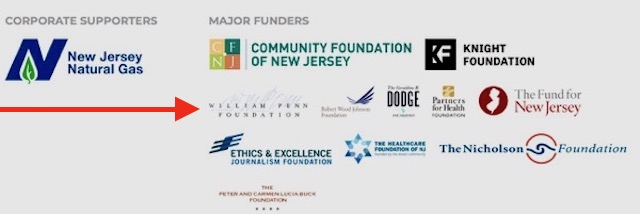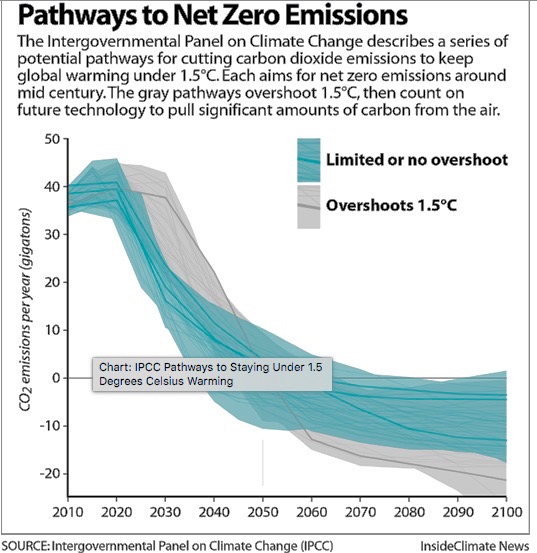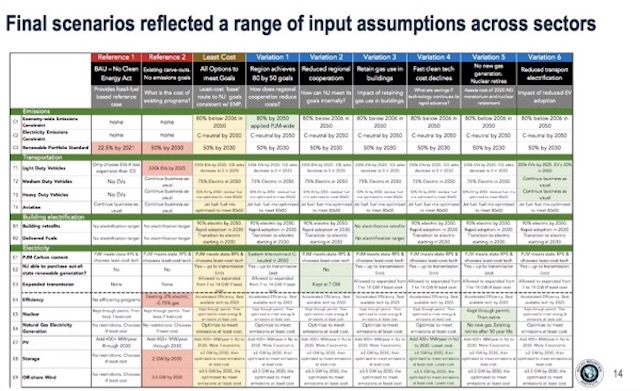Murphy DEP Narrowing The Scope of Climate Regulation – “Targeted” Reforms Designed To “Modernize” Regulations
Murphy DEP “Listening to All Sides”, including polluters, developers, & deniers
DEP Adopts posture of “Collaboration”, Not Leadership
[See End Note]
I recently wrote that the Murphy DEP was “running away from climate regulations“.
I based that initial assessment on over 35 years of DEP regulatory policy work, the Murphy administration’s climate record thus far, a cursory review of the Murphy Executive Order, and the framing of a NJ Spotlight story, particularly on how the DEP responded to very strong pushback from the business community.
Since then, DEP has formally announced their official climate regulatory rollout.
That regulatory process includes 3 discrete DEP defined topics and public “stakeholder meetings” as follows:
- 02/21/2020 – Periodic monitoring and reporting of New Jersey’s greenhouse gas emissions
- 02/25/2020 – Reducing carbon emissions in New Jersey
- 03/02/2020 – Adapting land use regulations to climate change impacts, including sea-level rise, extreme weather, and chronic flooding
I) Monitoring and Reporting
At the outset, let me note that “monitoring and reporting” on greenhouse gas emissions was mandated 13 years ago by the 2007 global Warming Response Act.
Prior to passage of the GWRA, in 2005, DEP adopted regulations that defined greenhouse gases as regulated “air contaminants” (i.e. “pollutants”) under the NJ State Air Pollution Control Act and required monitoring and reporting of emissions.
Additionally, in the 2007 RGGI law, a subset of major GHG polluters in the energy sector were required to monitor and report emissions.
And prior to all that, in the mid 1990’s, Whitman administration DEP Commissioner Shinn established the first DEP greenhouse gas emissions inventory.
So, DEP has been involved in GHG monitoring and reporting for almost 30 years. DEP should be managing a robust GHG emissions monitoring and reporting program. If that’s not the case, then we’re really in trouble. And if it is the case, then Gov. Murphy and DEP Commissioner McCabe, by creating the public appearance that this program is something new and important is totally misleading.
Instead, DEP should be reporting to the public about the strengths and weakness of the GHG monitoring and reporting program, including making specific recommendations to make it more comprehensive, transparent, accurate, and reliable – and be able to be integrated with and technically support a GHG emissions reduction regulatory program, which the structure of current monitoring and reporting can not do.
II) Reducing Carbon Emissions
The DEP’s public announcement lacks any specifics about the numeric emissions reductions and timetables that must be met to reflect “best available science”, or even define what “best available science” is.
That is a failure of leadership and it makes it appear that the fundamental GHG emission reduction goals and timetables are negotiable.
At a minimum, DEP should advise the public that the “best available” science includes the 2018 IPCC Special Report, that warned we must reduce emissions by 45% or more over the next decade.
Instead, the public must scroll through DEP’s rollout website to find a vague and weak “fact sheet”.
III) “Adapting Land Use Regulations to climate change”
By framing the issue this way, DEP has made and masks a HUGE policy concession.
DEP effectively has limited the scope of the land use climate program to adaptation, and not emissions reductions.
Development subject to DEP land use permit requirements not only must adapt to climate change, but that DEP regulated infrastructure, development and redevelopment also emit huge amounts of greenhouse gases that must be reduced.
The DEP land use programs must integrate missions reduction requirements.
New DEP permit requirements could mandate that developments subject to DEP land use permit requirements are:
1) zero carbon or carbon neutral;
2) offset any new carbon emissions;
3) planned, designed and constructed with energy in mind, from passive solar development layouts, preservation and planting of trees on and of-site, energy efficient insulation, building materials, and appliances, rooftop solar, smart metering, connectivity to micro-grids, off-grid storage, and accommodate electric vehicles at al.
But the DEP has defined that all away be restricting the scope of land use regulations to “adaptation”.
IV) “Stakeholder meetings” versus formal public hearings or negotiated rule-making
The DEP has chosen to develop the climate regulatory program via informal “stakeholder meetings”. That means that these meetings are not subject to the NJ Administrative Procedures Act or Gov. Murphy’s own troubling Executive Order on regulatory policy.
That decision has procedural and substantive consequences.
Procedurally, these meetings are informal. That means that the public is not guaranteed the protections that would be provided by “formal” procedures, like formal public hearings, where DEP is required to widely publish and publicize the public notices of the hearings. At these hearings, no one can be excluded and all voices must be heard on an equal basis. DEP is required to maintain a transcript of all public comments, DEP is required to respond to public comment, and the contents of the hearing form the “official record” of the rule making are transparent to the public and are subject to judicial and legislative review.
In contrast, DEP is under no such obligations in informal “stakeholder meetings”. That means that DEP can erect barriers that limit public involvement, like mandatory registration, limits on the duration of meetings and limited public notice of the meetings.
In addition to the above troubling DEP presentation of the regulatory framework, here’s how Murphy DEP Commissioner McCabe described the DEP climate regulation program: (emphases mine)
“As we work to modernize our environmental regulations to reflect the best available science, DEP is committed to a thoughtful and collaborative approach that engages stakeholders from across all sectors of our economy, non-governmental organizations, academia and local government. We are all in this together.”
There are a number of rhetorical and procedural red flags that tend to confirm my initial assessment.
First of all, the DEP is stressing problematic policy concepts, specifically “modernization“, “stakeholder meetings“,”collaboration“, and individual DEP defined topics (AKA regulatory “silos”).
And here’s another troubling one:
Due to space limitations, the DEP is requesting attendees to RSVP. …To attend, you MUST RSVP to the event using the RSVP For This EVENT link on below right.
Let’s discuss these problems one by one.
I) “Modernization”
Modernization is a policy neutral concept. Modern is in the eye of the beholder: does it mean “efficient”? Does it mean “least cost”? Does it mean least regulatory burden? Does it mean deepest and fastest greenhouse gas emissions”?
For an example of the dangers of modernization”, consider that President Bill Clinton “modernized” financial regulation via the “Financial Services Modernization Act of 1999 and the Commodity Futures Modernization Act of 2000.
Those “modernization” laws deregulated Wall Street and led to the 2008 financial collapse.
Gov. Murphy was making his fortune on Wall Street and benefited hugely from this “modernization”.
So, beware whenever a Wall Street Neoliberal Democrat pursues a policy of “modernization”.
II) Stakeholder meetings
(see above)
III) Collaboration
This is going to be a fight with powerful economic interests and their friends in the legislature and media. The Murphy DEP needs tremendous public support, which can only be generated by a bold proposal.
But the concept of collaboration is troubling and it undermines the concept of leadership.
With DEP setting out seeking “collaboration”, that is a very soft stance and invites all kinds of compromise, even capitulation.
IV) DEP’s definition of the issues and structure of the regulatory framework
See the above discussion of how DEP narrowed the scope of the land use regulatory program.
DEP also has done this by breaking the public sessions into discrete topics, thereby perpetuating a “silo” based approach and undermining effective public involvement.
By doing this, DEP is avoiding and undermining a more compressive and synthetic approach that could integrate both emission reductions and climate adaption in a unified regulatory framework.
V) Discouraging public involvement
(see above).
There’s no reason why the public should be required to register to participate.
DEP has stated that there are “space limitations” (capacity). That is unacceptable.
I assume DEP also will impose time limits on the meetings and the length of people’s testimony.
All of the above are more troubling signs. Often, the process dictates the outcome.
If so, there are many signs that we’re headed for the rocks.
[End Note: the comment function doesn’t work, so an informed reader sent me an email criticizing this post, as follows:
The standards for all that are already predetermined by the EMP . RGGI etc. Clean energy is incinerators , bio gas , bio mass subsidies nukes , CHP, and sequestration and off sets – the reduction electrical sector 30% 2030 by RGGI – 80% net reductions 2050 with offsets, carbon sequestration and bio gas.
I replied thusly:
I understand that – the post about all that substance is being written in my head. It’s coming. This is a series.
The point I’m trying to make in this post is that at the outset, DEP and the Gov. won’t talk about all that precisely BECAUSE the standards suck. They don’t mention lots of other stuff – like STATUTORY RGGI allowance caps, solar caps, et al that create barriers to even the Gov.’s weak emission reduction goals and timetables.
Failure to even MENTION all this substance in the Gov. Ex. Order 100 and at the outset of a DEP public process for regulatory development can only result in them getting even WEAKER in response to strong pushback by the business community and legislature – and with no fingerprints or even ability for the public to know what the hell went on.



